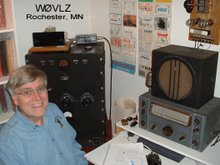The Novice Rig Roundup was my favorite. Its nine day operating window let me work around stormy weather, other contests, family obligations and propagation while still having fun.
I did find that I really like my Drake 2NT/R4B station. The 2NT operates break-in well with the R4B and its delay/timing circuit allows the crystal oscillator to run between code character elements. This minimizes chirp, even for the laziest of crystals. The R4B has KHz frequency readout and great filtering options. This pair is a keeper.
With almost 40 years of radio technology between my '29 transmitters and the 2NT it is not surprising that my '29 station is the more unique (and challenging) to use. Challenging, though, does not mean unusable. While unique and challenging my '29 station is still usable. Depending on conditions I can switch between an SW3, an early 30s National regenerative receiver, and my early 80s Drake SPR4. Once and a while it is good to go back and experience ham radio roots.
We've already had temperatures in the 60s this year. With spring arriving the snow has melted here in southeastern Minnesota. Now I'll start thinking about my QRP in the Park plans.





























